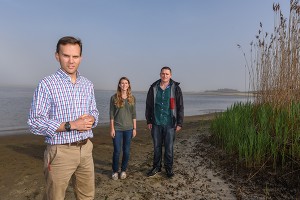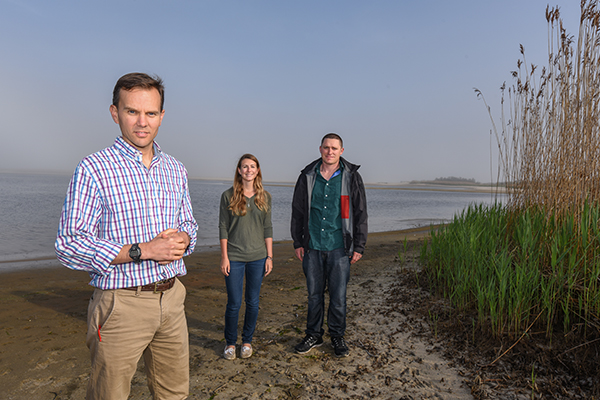Toxic algae blooms are among the most serious health risks in East Hampton pond
From Lauren Sheprow at the Stony Brook Newsroom

(Left to right): Stony Brook University School of Marine and Atmospheric Sciences Professor Christopher Gobler, PhD and graduate students/Pond Stewards Jennifer Jankowiak and Ryan Wallace launch research project on Georgica Pond water quality, Wainscott, NY.
EAST HAMPTON, N.Y., May 20, 2015 – Stony Brook University has partnered with a group of homeowners from the Georgica Pond community, and the East Hampton Town Trustees, to form a public-private partnership to address water quality issues on the east end of Long Island. Local residents have raised $359,000 to support the research project, which will investigate the causes of environmental degradation and the toxic algae blooms observed in Georgica Pond over the last several years. Research will be led by Dr. Chris Gobler, a professor at Stony Brook University’s School of Marine and Atmospheric Sciences. Based on the research findings, the partnership will work closely with the Nature Conservancy to develop a plan of action to remediate the Georgica Pond eco-system. This plan will also help inform other communities in Long Island facing similar water quality issues.
In recent years, the pond has experienced elevated levels of toxic algae blooms and dangerously low oxygen levels, which have posed a serious threat to the local eco-system. In 2012, a small dog died after drinking from the pond. An autopsy revealed levels of cyanobacteria in the dog’s stomach that led to neurotoxic shock and eventual death. Testing by Stony Brook in the summer of 2014 revealed high levels of toxic algae leading the pond to be closed for the first time ever. This closure has had a negative impact on many including summer visitors and local residents, who consider the pond an integral feature of their community.
Several Georgica Pond homeowners – led by Anna Chapman, Priscilla Rattazzi, and Annie and John Hall – have contributed funds to support Dr. Gobler’s research.
Anna Chapman commented that the research project marks a first small step towards addressing a large-scale problem across Long Island.
“This unsettling local problem is just one example of a growing global one – and confirms that no community can take the health of its water supply for granted. The partnership represents a unique opportunity to be ambitious in its goals – to generate research findings that can be valuable both on the local level and beyond, and solutions that are long-ranging rather than just short-term.”
Nancy Kelley, Director of The Nature Conservancy on Long Island, commented, “The research being conducted under the auspices of Dr. Chris Gobler, a world-renowned expert in harmful algae blooms, will provide information necessary to restore and maintain Pond health. This study and the subsequent actions taken by government and residents can serve as a model for how water quality across Long Island and beyond can be restored for people and nature.”
The $359,000 research project will focus on investigating the source of pollution in the pond. One of the key elements of the project will be the installation of a telemetry device that allows for continuous monitoring of multiple water quality indicators, such as the level of algae and oxygen in the water. The device will also record and send data to a web address on an ongoing basis for easy monitoring. In addition, researchers will be sample ground water and other tributaries to the pond. Finally, a graduate student will be appointed from Dr. Gobler’s lab to act as a “Georgica Pond Steward” to oversee the data collection and analysis.
“We know that the water quality conditions in Georgica Pond pose a serious threat to wildlife, pets and humans – and that it will intensify without intervention,” said Dr. Chris Gobler. “Our study is designed to identify the sources and quantify the delivery rates of nitrogen and phosphorus. Coupling these measurements with a robust characterization of the blue green algae in the Pond as well as their toxins will permit informed remedial measures to be implemented.”
Stephanie Forsberg, East Hampton Town Trustee remarked on the public-private partnership, “We hope to establish data sets and trends with Dr. Gobler and Stony Brook University to establish a knowledge base that will allow Trustees to move forward in remediation, and problem solving with other public entities, to ensure that Georgica Pond remains a resource for all to enjoy for generations to come.”
– See more at: http://sb.cc.stonybrook.edu/news/general/2015-05-20-georgica-pond.php?=marquee4#sthash.bsiTHX02.dpuf




